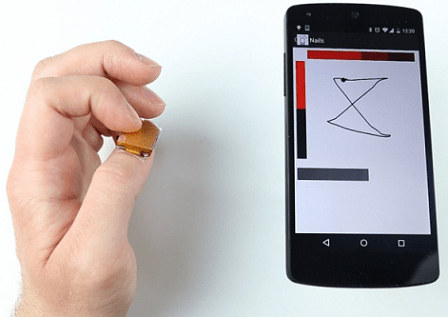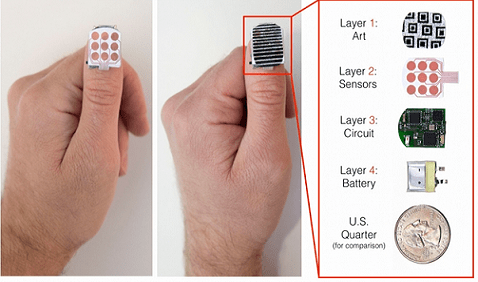MIT Researchers Develop 'NailO' - A Wireless Thumbnail-Shaped Track Pad
With a vision of developing a technology that would allow the users to control wireless devices when their hands are busy while doing other stuffs such as cooking, driving, eating, et al, the researchers at MIT Media Laboratory have developed a prototype called NailO. This novel wearable device basically turns the user’s thumbnail into a wireless track pad without causing any discomfort. The small-sized prototype consists of capacitive sensors, a battery along with three discrete chips namely- microcontroller, Bluetooth radio chip, and capacitive-sensing chip. NailO is quite fascinating because many of us may prefer to work with our thumbnail rather than using gestures or speech while interacting with digital devices such as smartphones, tablets, et al.

Designing an antenna was not an easy job because it should be away from the chips. If the antenna is close to the chips then there are chances that it may interfere with them. The team was divided into two sub-teams. One sub-team concentrated on the circuit design, whereas the other part of the team worked on the software. The main job of the software is to interpret signal from the capacitive sensors. After filtering out the noise from the signal, the software then translates the signal into movements on the screen. During the inception period of the prototype, the researchers were able to test different electrode layouts. This was possible because of the sensors built by printing copper electrodes on sheets of flexible polyester.

The researchers want to modify and refine the circuit design of the track pad by using a small-scale battery that is just half a millimeter thick. They are also looking for a special-purpose chip that when deployed can perform the functions of three chips- microcontroller, radio, and capacitive sensor. Moreover, they also want to maintain energy efficiency of the device. In other words, NailO should turn off itself when not in use. The latest research paper reports the results of the study that compared various methods for turning it on and off. One method demonstrates that the surface contact with the operator’s finger for only 2 or 3 seconds is sufficient to activate and deactivate the track pad. The team also envisions that the commercial variant of the NailO would have a detachable membrane on its surface so that the users could attach stylish nail-art layers as per their outfits.
The research paper will be presented at the Association for Computing Machinery’s Computer-Human Interaction (ACM- CHI) conference in Seoul, South Korea.
Source: #-Link-Snipped-#
Designing an antenna was not an easy job because it should be away from the chips. If the antenna is close to the chips then there are chances that it may interfere with them. The team was divided into two sub-teams. One sub-team concentrated on the circuit design, whereas the other part of the team worked on the software. The main job of the software is to interpret signal from the capacitive sensors. After filtering out the noise from the signal, the software then translates the signal into movements on the screen. During the inception period of the prototype, the researchers were able to test different electrode layouts. This was possible because of the sensors built by printing copper electrodes on sheets of flexible polyester.
The researchers want to modify and refine the circuit design of the track pad by using a small-scale battery that is just half a millimeter thick. They are also looking for a special-purpose chip that when deployed can perform the functions of three chips- microcontroller, radio, and capacitive sensor. Moreover, they also want to maintain energy efficiency of the device. In other words, NailO should turn off itself when not in use. The latest research paper reports the results of the study that compared various methods for turning it on and off. One method demonstrates that the surface contact with the operator’s finger for only 2 or 3 seconds is sufficient to activate and deactivate the track pad. The team also envisions that the commercial variant of the NailO would have a detachable membrane on its surface so that the users could attach stylish nail-art layers as per their outfits.
The research paper will be presented at the Association for Computing Machinery’s Computer-Human Interaction (ACM- CHI) conference in Seoul, South Korea.
Source: #-Link-Snipped-#
Replies
You are reading an archived discussion.
Related Posts
What is the difference between a three pin plug and a two pin plug?
And what are those three pin used for?
Expecting a detailed answer...
Remember, a year back we had talked about the oPhone, an iDevice attachment that allowed you to send aromas/smelly messages to another oPhone user. The creator of the oPhone, Professor...
guys help me with this
What is the effective address generated by the following instructions? Every instruction is independent of others. Initially BX=0x0100, num1=0x1001, [num1]=0x0000, and SI=0x0100
a. mov ax,...
Sony Corporation has announced the launch of its new mid-budget Android smartphone called Xperia E4G in India. Having a 1.5 GHz Quad Core (MediaTek MT6732) processor at is core, the...
Russian President Putin wants to build RSS: 'Russian Space Station'. Calling it an 'economic necessity', Putin said that in the longer term, the Russian Space Station is going to be...
